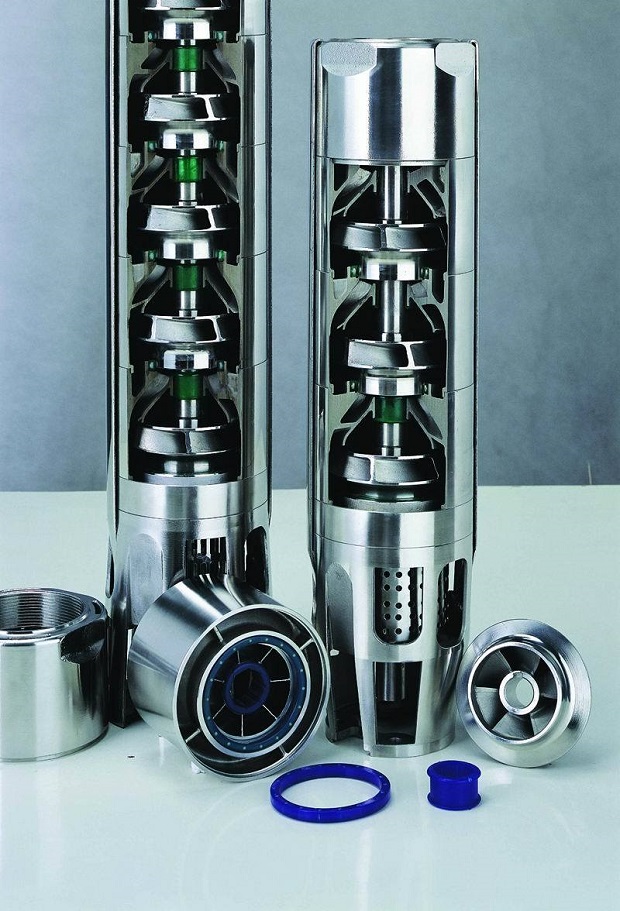Aquatech
Electric Submersibles

Electric submersible pumps come in a variety of models with specific limitations. Electric submersibles come with the pump configured to single or three phase and with manual or automatic panels. Most submersible pumps do not have variable frequency drives (VFD’s) which allows control of the RPM of the electric motor, so the RPM is fixed. The motor therefore runs at a specific RPM turning the impeller, which throws the fluid out with a consistent force during its run time. Consider the following areas a guide aimed at helping users select the electric submersible pump that’s right for the job.
What Are You Pumping?
Relatively clean storm water with some grit can be pumped using the GSP line of submersible water pumps. Sludge and slurries can be pumped by the GSL line.
Solids Capability
GSP models have 7.5mm from ½ hp to 13 hp clean water pumps and 13.0mm solids from 16 hp to 60 hp. GST05 and GST10 have 1” or 25mm solids handling capability and 2” or 50mm with the GSL30, GSL35 and GSL60 models. The GSL 80 has 3 different specifications for solids handling: HH is 1.3” (33mm); HV is 2” (50mm); SV is 3.2” or 81mm.
Flow Requirements
Flow requirements may be simple such as matching flow and TDH with an appropriate pump. More often, closer attention must be paid to the specific gravity of the liquid or slurry, sump size, discharge rates, line size, head, slope, water hammer, valves, controllers, VFD’s and pressure requirements. Any individual factor can negatively affect the expected performance of the total system. Contact your local Aquatech representative to assess your requirements to ensure a comprehensive and functional design with the desired results.
Lift/Total Head Requirements
Horsepower and impeller design are the two most prominent factors that determine the TDH capability of any given pump. Other factors can have an effect as well, including discharge pipeline material and the coefficient of friction. Most pump curves show the shut-off head for a specific model on the extreme left of each curve. That is, the TDH that the specific model shuts off or ceases to discharge. This is the maximum height that this pump can lift water. As head decreases volume output increases, unless a Variable Frequency Drive (VFD) is used or voltage is decreased, which affects the pump’s RPM and contributes to decreased performance.
Voltage and Starting/Running Amp Requirements
Pumps will run on a specific voltage – single phase pumps in 115 volt and 230 volt, and three phase pumps in 230 volt and 575 volt. Each pump has specific starting amperage and running amperage, while each electric source to the respective pump must be able to withstand the starting and running amperage. Each pump has a box that is wired especially for that pump performance with built-in resistors and capacitors to protect the pump from surges and low power.
A common problem with temporary submersible pump installation is gray power or when the expected voltage is lower or higher than the actual voltage, or in some cases the power fluctuates. The most common under voltage is when 230 volt, 3 phase is expected only to find that 208 volt, 3 phase is being delivered. These inconsistencies in power delivery can burn out a pump or diminish pump performance. Three phase pumps can generally deliver more head than single phase pumps (with same impeller designs) due to the horsepower required in overcoming larger head requirements. An example of the power loss from model to model is evident in the 230 volt single phase, GSL60 and 575 volt, 3 phase GSL80. The same electric motor is used for both pumps but the resulting horsepower loss due to the single phase versus 3 phase is a full two horsepower.
Distance from Power Source
Each pump comes with specific length cable. When length is added to these cables, expect reduced performance from the pump. When going beyond the supplied length of cable always consider upsizing that cable to reduce the electrical friction loss from the longer cable, as this would result in reduced pump performance.
Type of Power Source
Always know what power is available. If matching a pump with ground power it’s important to know source specifications. If using temporary power from a generator, make sure that the generator has the capability of delivering the correct voltage and the breakers are adequate to withstand the starting and running amps of the pumps.
Types of Control Boxes
Each pump comes with either manual or automatic controls. Some single phase 115 volt pumps are plug-in but it is possible to plug into a manual or automatic panel box that allows off/on manual control or automatic float control. Each of these boxes is specifically wired with resistors, capacitors and in the case of automatic controllers, starters. The resistors and capacitors protect the more expensive pump motor from power surges and lack of power. The automatic controllers allow the convenience of float installation and these boxes can be switched to manual when desired if floats are not required.
Source: http://aquatechpumpandpower.com/rentals_sales_details.php?Electric-Submersibles-4
Magazine
No information